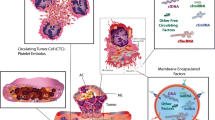Abstract
The measurement of circulating vascular endothelial growth factor (VEGF) levels as a prognostic factor will gain increasing relevance in the diagnosis and evaluation of treatment in cancer patients. Angiogenesis is an absolute requirement in tumour growth and metastatic disease. In the present study data are presented which indicate that circulating VEGF mainly resides in peripheral blood cells. In 15 healthy volunteers we demonstrated that approximately 34% of the circulating VEGF resides in platelets and approximately 11% in patients with cancer (n= 4). An important part namely 58% in healthy volunteers and 69% in patients with cancer of the total circulating VEGF is contained in granulocytes, particular in the neutrophils, as confirmed by fluorescence-activated cell sorting (FACS). Also an increased VEGF level per granulocyte is found in patients with cancer (77 μg VEGF/l) compared with the healthy volunteers (164 μg VEGF/l). In contrast only 2% was present in plasma. The biological significance of platelet- or granulocyte-derived VEGF is not yet known. Liberation of VEGF from these compartments could well be of importance for tumour angiogenesis. Therefore, future studies on the clinical value of circulating VEGF as a prognostic factor in cancer patients should include measurements of VEGF in peripheral blood cells.
Similar content being viewed by others
References
Senger DR, Galli SJ, Dvorak AM et al. Tumor cells secrete a vascular permeability factor that promotes accumulation of ascites fluid. Science 1983; 219: 983–5.
Ferrara N. Vascular endothelial growth factor. Eur J Cancer 1996; 32A: 2413–22.
Adams J, Carder PJ, Downey S et al. Vascular endothelial growth factor (VEGF) in breast cancer: Comparison of plasma, serum, and tissue VEGF and microvessel density and effects of tamoxifen. Cancer Res 2000; 60: 2898–905.
Oehler MK, Caffier H. Prognostic relevance of serum vascular endothelial growth factor in ovarian cancer. Anticancer Res 2000; 20: 5109–12.
Kumar H, Heer K, Lee PW et al. Preoperative serum vascular endothelial growth factor can predict stage in colorectal cancer. Clin Cancer Res 1998; 4: 1279–85.
Ugurel S, Rappl G, Tilgen W, Reinhold U. Increased serum concentration of angiogenic factors in malignant melanoma patients correlates with tumor progression and survival. J Clin Oncol 2001; 19: 577–83.
Matsuyama W, Hashiguchi T, Mizoguchi A et al. Serum levels of vascular endothelial growth factor dependent on the stage progression of lung cancer. Chest 2000; 118: 948–51.
Verheul HM, Hoekman K, Luykx-de Bakker S et al. Platelet: Transporter of vascular endothelial growth factor. Clin Cancer Res 1997; 3: 2187–90.
Webb NJ, Bottomley MJ, Watson CJ, Brenchley PE. Vascular endothelial growth factor (VEGF) is released from platelets during blood clotting: Implications for measurement of circulating VEGF levels in clinical disease. Clin Sci (Lond) 1998; 94: 395–404.
Banks RE, Forbes MA, Kinsey SE et al. Release of the angiogenic cytokine vascular endothelial growth factor (VEGF) from platelets: Significance for VEGF measurements and cancer biology. Br J Cancer 1998; 77: 956–64.
Wynendaele W, Derua R, Hoylaerts MF et al. Vascular endothelial growth factor measured in platelet poor plasma allows optimal separation between cancer patients and volunteers: A key to study an angiogenic marker in vivo? Ann Oncol 1999; 10: 965–71.
Salven P, Orpana A, Joensuu H. Leukocytes and platelets of patients with cancer contain high levels of vascular endothelial growth factor. Clin Cancer Res 1999; 5: 487–91.
Loken MR, Brosman JM, Ault KA et al. Establishing Optimal Lymphocyte Gates for Immunophenotyping using LeucoGate, Beckton Dickinson Immunocytometry Systems. San Jose, California: Becton Dickinson 1998.
Mohle R, Green D, Moore MA et al. Constitutive production and thrombin-induced release of vascular endothelial growth factor by human megakaryocytes and platelets. Proc Natl Acad Sci USA 1997; 94: 663–8.
Gaudry M, Bregerie O, Andrieu V et al. Intracellular pool of vascular endothelial growth factor in human neutrophils. Blood 1997; 90: 4153–61.
Scapini P, Calzetti F, Cassatella MA. On the detection of neutrophil-derived vascular endothelial growth factor (VEGF). J Immunol Meth 1999; 232: 121–9.
Freeman MR, Schneck FX, Gagnon ML et al. Peripheral blood T lymphocytes and lymphocytes infiltrating human cancers express vascular endothelial growth factor: A potential role for T cells in angiogenesis. Cancer Res 1995; 55: 4140–5.
Katoh O, Tauchi H, Kawaishi K et al. Expression of the vascular endothelial growth factor (VEGF) receptor gene, KDR, in hematopoietic cells and inhibitory effect of VEGF on apoptotic cell death caused by ionizing radiation. Cancer Res 1995; 55: 5687–92.
Bottomley MJ, Webb NJ, Watson CJ et al. Peripheral blood mononuclear cells from patients with rheumatoid arthritis spontaneously secrete vascular endothelial growth factor (VEGF): Specific up-regulation by tumour necrosis factor-alpha (TNFalpha) in synovial fluid. Clin Exp Immunol 1999; 117: 171–6.
Griga T, Gutzeit A, Sommerkamp C, May B. Increased production of vascular endothelial growth factor by peripheral blood mononuclear cells in patients with inflammatory bowel disease. Eur J Gastroenterol Hepatol 1999; 11: 175–9.
Dvorak HF, Brown LF, Detmar M, Dvorak AM. Vascular permeability factor/vascular endothelial growth factor, microvascular hyperpermeability, and angiogenesis. Am J Pathol 1995; 146: 1029–39.
Author information
Authors and Affiliations
Corresponding author
Rights and permissions
About this article
Cite this article
Kusumanto, Y.H., Dam, W.A., Hospers, G.A. et al. Platelets and Granulocytes, in Particular the Neutrophils, Form Important Compartments for Circulating Vascular Endothelial Growth Factor. Angiogenesis 6, 283–287 (2003). https://doi.org/10.1023/B:AGEN.0000029415.62384.ba
Issue Date:
DOI: https://doi.org/10.1023/B:AGEN.0000029415.62384.ba




